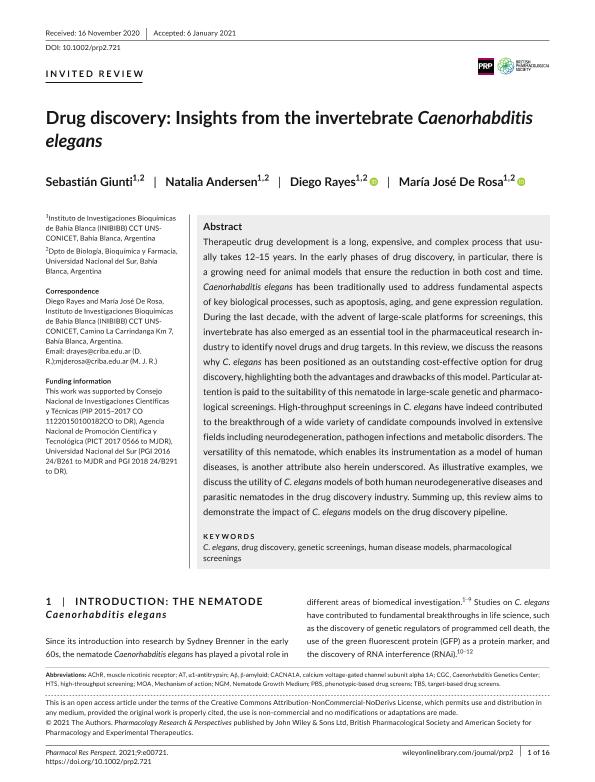Mostrar el registro sencillo del ítem
dc.contributor.author
Giunti, Sebastián

dc.contributor.author
Andersen, Natalia Denise

dc.contributor.author
Rayes, Diego Hernán

dc.contributor.author
de Rosa, Maria Jose

dc.date.available
2021-07-26T15:08:54Z
dc.date.issued
2021-04-09
dc.identifier.citation
Giunti, Sebastián; Andersen, Natalia Denise; Rayes, Diego Hernán; de Rosa, Maria Jose; Drug discovery: Insights from the invertebrate Caenorhabditis elegans; John Wiley & Sons Ltd; Pharmacology Research and Perspectives; 9; 2; 9-4-2021; 1-16; e00721
dc.identifier.uri
http://hdl.handle.net/11336/136932
dc.description.abstract
Therapeutic drug development is a long, expensive, and complex process that usually takes 12–15 years. In the early phases of drug discovery, in particular, there is a growing need for animal models that ensure the reduction in both cost and time. Caenorhabditis elegans has been traditionally used to address fundamental aspects of key biological processes, such as apoptosis, aging, and gene expression regulation. During the last decade, with the advent of large-scale platforms for screenings, this invertebrate has also emerged as an essential tool in the pharmaceutical research industry to identify novel drugs and drug targets. In this review, we discuss the reasons why C. elegans has been positioned as an outstanding cost-effective option for drug discovery, highlighting both the advantages and drawbacks of this model. Particular attention is paid to the suitability of this nematode in large-scale genetic and pharmacological screenings. High-throughput screenings in C. elegans have indeed contributed to the breakthrough of a wide variety of candidate compounds involved in extensive fields including neurodegeneration, pathogen infections and metabolic disorders. The versatility of this nematode, which enables its instrumentation as a model of human diseases, is another attribute also herein underscored. As illustrative examples, we discuss the utility of C. elegans models of both human neurodegenerative diseases and parasitic nematodes in the drug discovery industry. Summing up, this review aims to demonstrate the impact of C. elegans models on the drug discovery pipeline.
dc.format
application/pdf
dc.language.iso
eng
dc.publisher
John Wiley & Sons Ltd

dc.rights
info:eu-repo/semantics/openAccess
dc.rights.uri
https://creativecommons.org/licenses/by-nc-sa/2.5/ar/
dc.subject
C. ELEGANS
dc.subject
DRUG DISCOVERY
dc.subject
GENETIC SCREENINGS
dc.subject
HUMAN DISEASE MODELS
dc.subject
PHARMACOLOGICAL SCREENINGS
dc.subject.classification
Bioquímica y Biología Molecular

dc.subject.classification
Ciencias Biológicas

dc.subject.classification
CIENCIAS NATURALES Y EXACTAS

dc.title
Drug discovery: Insights from the invertebrate Caenorhabditis elegans
dc.type
info:eu-repo/semantics/article
dc.type
info:ar-repo/semantics/artículo
dc.type
info:eu-repo/semantics/publishedVersion
dc.date.updated
2021-06-10T19:27:01Z
dc.identifier.eissn
2052-1707
dc.journal.volume
9
dc.journal.number
2
dc.journal.pagination
1-16; e00721
dc.journal.pais
Reino Unido

dc.journal.ciudad
Oxford
dc.description.fil
Fil: Giunti, Sebastián. Consejo Nacional de Investigaciones Científicas y Técnicas. Centro Científico Tecnológico Conicet - Bahía Blanca. Instituto de Investigaciones Bioquímicas de Bahía Blanca. Universidad Nacional del Sur. Instituto de Investigaciones Bioquímicas de Bahía Blanca; Argentina. Universidad Nacional del Sur. Departamento de Biología, Bioquímica y Farmacia; Argentina
dc.description.fil
Fil: Andersen, Natalia Denise. Consejo Nacional de Investigaciones Científicas y Técnicas. Centro Científico Tecnológico Conicet - Bahía Blanca. Instituto de Investigaciones Bioquímicas de Bahía Blanca. Universidad Nacional del Sur. Instituto de Investigaciones Bioquímicas de Bahía Blanca; Argentina. Universidad Nacional del Sur. Departamento de Biología, Bioquímica y Farmacia; Argentina
dc.description.fil
Fil: Rayes, Diego Hernán. Consejo Nacional de Investigaciones Científicas y Técnicas. Centro Científico Tecnológico Conicet - Bahía Blanca. Instituto de Investigaciones Bioquímicas de Bahía Blanca. Universidad Nacional del Sur. Instituto de Investigaciones Bioquímicas de Bahía Blanca; Argentina. Universidad Nacional del Sur. Departamento de Biología, Bioquímica y Farmacia; Argentina
dc.description.fil
Fil: de Rosa, Maria Jose. Consejo Nacional de Investigaciones Científicas y Técnicas. Centro Científico Tecnológico Conicet - Bahía Blanca. Instituto de Investigaciones Bioquímicas de Bahía Blanca. Universidad Nacional del Sur. Instituto de Investigaciones Bioquímicas de Bahía Blanca; Argentina. Universidad Nacional del Sur. Departamento de Biología, Bioquímica y Farmacia; Argentina
dc.journal.title
Pharmacology Research and Perspectives
dc.relation.alternativeid
info:eu-repo/semantics/altIdentifier/url/https://bpspubs.onlinelibrary.wiley.com/doi/10.1002/prp2.721
dc.relation.alternativeid
info:eu-repo/semantics/altIdentifier/doi/http://dx.doi.org/10.1002/prp2.721
Archivos asociados
